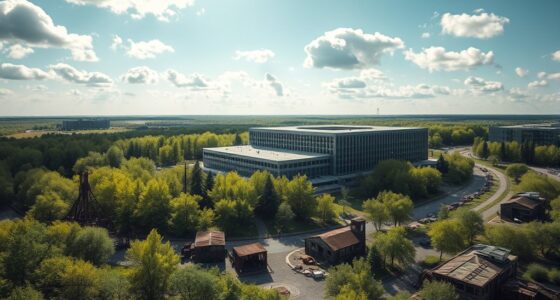The Grenfell Tower fire in 2017 revealed serious flaws in building safety standards and regulatory enforcement. You learn that unsafe cladding materials and poorly maintained fire safety measures contributed to the tragedy. Weak enforcement and outdated regulations allowed these issues to persist, highlighting the need for stricter oversight and accountability. Understanding these failures underscores why continuous review and strict compliance are essential, and there’s more to explore about lessons learned and ongoing reforms.
Key Takeaways
- The Grenfell Tower fire revealed critical failures in building materials, especially non-compliant cladding that exacerbated fire spread.
- Regulatory oversight was insufficient, highlighting the need for stricter enforcement and regular safety inspections.
- Building safety depends on adherence to fire-resistant standards, proper maintenance, and functional safety systems.
- Post-incident reforms aimed to tighten fire safety regulations and ensure accountability from authorities and construction firms.
- The tragedy underscored the importance of transparency, continuous oversight, and proactive safety measures to prevent future disasters.

On June 14, 2017, a devastating fire engulfed Grenfell Tower in London, resulting in tragic loss of life and widespread shock. This catastrophe exposed critical flaws in how building regulations and fire safety measures are implemented and enforced. As someone concerned with building safety, you need to understand that regulations are designed to protect residents by setting standards for construction, materials, and safety systems. However, the Grenfell fire revealed that these standards can be overlooked or inadequately enforced, leading to catastrophic consequences.
You might wonder how such a tragedy could happen in a modern tower. A key issue was the building’s cladding material, which did not meet fire safety standards. Cladding is meant to prevent fire spread, but in this case, it contributed to the rapid escalation of the blaze. This highlights the importance of strict adherence to building regulations, specifically regarding fire safety. When regulations are compromised or ignored, the risk of a fire spreading out of control increases dramatically. Fire safety isn’t just about installing alarms or sprinklers; it involves comprehensive measures, including fire-resistant materials, proper evacuation routes, and ongoing inspections to ensure compliance.
The Grenfell disaster underscores the need for rigorous enforcement of building regulations. You must recognize that regulations are only effective if regularly updated, properly followed, and enforced by authorities. When regulations are outdated or when builders cut corners, safety systems may be compromised. For example, the tower’s fire doors failed, and the inadequate fire safety measures meant residents couldn’t evacuate safely. This situation emphasizes that fire safety should be integrated into every aspect of building design and maintenance, not treated as an afterthought. Additionally, regular inspections and audits are essential to identify and correct safety lapses before they lead to tragedy.
In the aftermath of Grenfell, accountability became a crucial issue. Governments, regulatory agencies, and construction companies faced scrutiny for their roles in allowing a building to be constructed and maintained in a way that was so perilous. You should understand that accountability means continuously reviewing and improving regulations, ensuring compliance, and holding those responsible accountable when standards are not met. The tragedy pushed for reforms in building regulations to tighten fire safety requirements and prevent similar incidents.
Ultimately, the Grenfell Tower fire serves as a stark reminder of the vital importance of building regulations and fire safety. You have a responsibility to advocate for strict adherence to safety standards, to demand transparency from construction and regulatory bodies, and to prioritize the safety of residents. Only through rigorous regulation, diligent enforcement, and accountability can we hope to prevent future tragedies like Grenfell.
Frequently Asked Questions
What Safety Measures Have Been Implemented Since the Fire?
Since the fire, you’ve seen significant fire safety upgrades, including improved sprinkler systems, better fire-resistant materials, and enhanced evacuation procedures. Regulation enforcement has also increased, ensuring building codes are strictly followed. These measures aim to protect residents and prevent future tragedies. By prioritizing fire safety upgrades and stricter regulation enforcement, authorities are working to create safer living environments and hold accountable those responsible for building safety.
Who Was Held Accountable for the Building’s Safety Failures?
You should know that legal accountability for Grenfell’s safety failures led to several convictions, including those of fire safety officials. notably, over 80 safety violations were identified shortly after the fire. Since then, policy reforms have been introduced to improve building safety standards. These changes aim to hold responsible parties more accountable and prevent such tragedies from happening again, emphasizing the importance of strict adherence to safety regulations.
How Did the Fire Safety Regulations Change After 2017?
After 2017, fire safety legislation and building regulation reforms became stricter to prevent tragedies like Grenfell. You’ll notice enhanced requirements for cladding, insulation, and fire alarms, along with mandatory safety checks. These reforms aim to improve oversight, accountability, and resident safety. You’re encouraged to stay informed about compliance standards, ensuring buildings meet the new regulations and contribute to safer communities.
What Support Has Been Provided to Survivors and Families?
You’ve received essential support through mental health services, financial aid, and ongoing counseling. You’re offered mental health support to help process trauma, financial assistance to cover immediate needs, and long-term programs to rebuild lives. You’re provided with emotional support, practical help, and community resources, ensuring you’re not alone in your recovery. This all-encompassing support aims to restore stability, hope, and resilience amidst the challenges you face.
Are Similar Buildings at Risk of Similar Fire Hazards Now?
You should know that many buildings still face fire risks if they haven’t updated their building codes and fire prevention measures. Authorities have strengthened regulations, but if buildings haven’t been properly inspected or maintained, they could still be vulnerable. It’s essential for building owners and residents to stay informed about safety standards, verify fire prevention systems are in place, and advocate for regular safety checks to prevent similar hazards.
Conclusion
The Grenfell Tower tragedy reminds you that safety should never be overlooked. When standards are overlooked or ignored, it’s a gentle nudge that future tragedies can be avoided through accountability and care. Let’s honor those affected by ensuring buildings are safe and regulations are upheld. By staying vigilant and demanding better oversight, you help shape a safer future for everyone, turning painful lessons into guiding light that prevents another silent, unintended harm.










